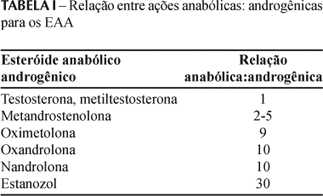Anabolic androgenic steroids (AAS) are a group of natural and synthetic agents formed from testosterone or one of its derivatives, whose classical therapeutic indications are associated to hipogonadism and deficiency of proteic metabolism. Acting on androgenic receptors, they modulate both the androgenic and anabolic effects. These substances vary in their ratio of anabolic:androgenic activity, but to date there is no substance that completely separates these effects, promoting only the anabolic ones. The first recorded use of AAS to improve the athletic performance occurred in 1954, in Austria, and since then this practice became widespread. Obviously, the use of AAS is out of the competitive limits, and was declared illegal by the national and international sportive governmental sectors. However, according to statistics of the International Olympic Committee, carried out in 2000, the AAS are the group of ergogenic aids most commonly used in the doping process. Studies show that supra-physiological doses of AAS can cause many adverse effects, such as atrophy of testicular tissue, hepatic and prostatic tumors, hepatocellular damage and alterations on the lipidic metabolism, on the humor and on the behavior. The aim of the present study is to compile the data regarding the AAS, involving their historical perspectives, the physiology of AAS and the existing AAS types, their therapeutic indications and the side effects resultant of the abuse of these substances and the relation between the use of AAS and the improvement of athletic performance
Anabolic androgenic steroids; Physical exercise; Performance



